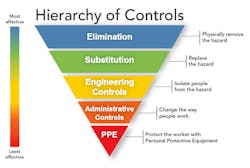Reducing risk to a level that is considered as low as reasonably possible should be the goal of every electrical professional. Using risk reduction strategy according to the hierarchy of controls is one of the concepts OSHA employs to achieve this aim. This concept ranks control measures in terms of their effectiveness in managing or eliminating hazards — the basis being that the control measures at the top of the ranking are more effective than those at the bottom. Inherently, safer systems are usually implemented when this hierarchy is followed, which also leads to a substantial reduction in risks of injury and illness.
Though different hierarchy of control models have been developed over the years, the National Institute for Occupational Safety and Health (NIOSH) represents the hierarchy of controls through its Prevention through Design initiative as follows:
Elimination: Physically removing the hazard from the workplace. It’s considered the most effective but most difficult method to implement in an existing system. An example is eliminating a hazardous chemical process from a job site.
Substitution: Replacing the risk with a less hazardous system. This could encompass replacing a highly hazardous chemical with a less hazardous one.
Engineering controls: Isolating people from the hazard. One example is installing guards on equipment to keep workers away from potential danger or rerouting trucks and footpaths away from overhead power lines.
Administrative controls: Changing the way people work and limiting people’s exposure by adjusting work tasks or schedules. Examples include reducing the time the worker is exposed to a hazard and using warning signs.
Personal protective equipment (PPE): The use of PPE to protect the worker. In construction, this may include hard hats, safety glasses, steel-toed shoes, ear protection, gloves, etc. PPE is considered the least effective of all the controls.
Reducing risk via the hierarchy of controls is a fundamental way of protecting workers. One of the best ways to ensure workers are implementing the control methods is by conducting operational risk management (ORM) daily work briefings, in which the hierarchy of controls is a key topic. This is considered a “human performance tool” intended to generate awareness of hazards and lead workers to modify job sites, workflow, and procedures for the purpose of reducing error or potential for error. The ORM should be designed to ensure every task is analyzed and carried out safely.
As part of your ORM, ask workers to identify hazards associated with their tasks, and devise ways of controlling the hazards. Employees should be trained to control all hazards by following the hierarchy of controls in order of effectiveness. For example, consider fabricating work on the ground to eliminate fall hazards, substitute the use of ladders with lifts where feasible, embed sleeves in slabs to prevent core drilling, rotate jobs among employees, use caution signs, and employ PPE as the final line of defense against hazards.
The use of the hierarchy of controls should be at the core of all risk-reduction strategies. Emphasis should always be placed at the top of the hierarchy, which requires eliminating or substituting the hazard when feasible. There is no doubt that when effectively implemented, this strategy helps create a safer workplace.
Amara is the safety director at Faith Technologies, Menasha, Wis. He can be reached at [email protected].

